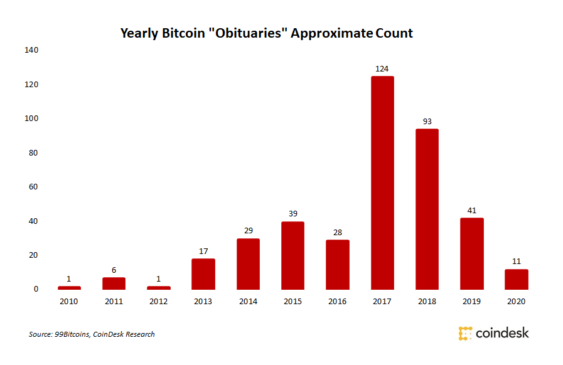Bitcoin has been declared dead or dying roughly 390 times since 2010. But this year it’s dying much less frequently.
In 2020, bitcoin has been reported dead or dying only 11 times, per a list of these faux obituaries maintained by a Singapore-based website called 99 Bitcoins.
Bitcoin’s yearly “obituary” count hasn’t been so low since 2012, three years after Bitcoin launched. The team behind the website confirmed to CoinDesk the list is actively maintained to date.
The sharp decrease in obituaries correlates with bitcoin’s record-breaking price action this year after breaking its 2017 all-time high in November with a total year-to-date gain of over 270%.
In the past, it was “in vogue to publicly dismiss or even shame those who believed in Bitcoin’s value proposition,” said Kevin Kelly, global macro strategy lead at Delphi Digital and former equity analyst at Bloomberg, in a direct message with CoinDesk.
But now the game has changed.
“Mass retail speculation and viral memes have been swapped for family offices and world-class macro investors,” Kelly said.
Bitcoin’s quickly-growing cadre of institutional buyers includes giants like MassMutual and Guggenheim. And their sizeable investments – combined with signs of rekindled retail interest – make announcing the bellwether cryptocurrency’s death increasingly difficult.
In a December bitcoin report, Kelly’s research team wrote, “Institutional investors have not only turned net long since September, but also the magnitude of their net exposure, measured in BTC, has increased relative to prior periods as well.”
Curiously, authors of disingenuous bitcoin “obituaries” have overlooked both times when the network actually has “died,” according to Pierre Rochard, Kraken’s lead bitcoin strategist.
In 2010, an inflation bug briefly enabled anyone using the network to create an infinite amount of bitcoins, which, for many intents and purposes, caused the network to die, Rochard said. In 2013, Bitcoin “died” a second time when a flawed version of its source code unexpectedly caused the block size limit to increase.
“In both cases bitcoin was promptly resurrected by the collective will of its users,” Rochard said. To save the network, bitcoin nodes reverted to an older version of the software in 2013 and rewound the blockchain back to a point before the inflation bug in 2010.
“Few critics understand what happened when bitcoin actually died, twice,” Rochard told CoinDesk in an email.
In the aftermath of these incidents, bitcoin’s “robust” fundamentals and “rapid adoption” have created market conditions with multiple “parabolic revaluations,” Rochard said, increasing both its adoption and the attention paid to its technical strength, leaving skeptics with little room for continued death pronouncements.
As bitcoin lives on, “the career risk is no longer from embracing bitcoin,” according to Kelly. “It’s from failing to give [bitcoin] the time and respect it deserves.”




